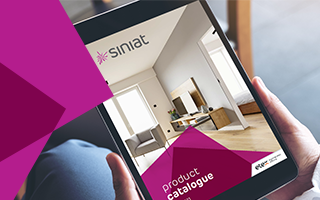The installation of plasterboard seems like a simple and straightforward process but as always, the devil is in the detail. It’s important to choose the right fasteners for the job to ensure the long-term success of the system.
Applicable standards
The following standards apply to plasterboard fasteners:
-
AS2589 Gypsum Linings – Application and Finishing describes the requirements for plasterboard fasteners and how they are installed.
-
Plasterboard screws and fasteners need to comply with AS3566, Self-drilling screws for the building and construction industries and be a minimum of Class 1 finish.
These standards are incorporated in all the relevant Siniat Technical Literature for installing plasterboard.
Nails or screws?
In terms of the Australian Standards, nails are still permitted when installing plasterboard. However, most professional plasterers now prefer using screws with a collated screw gun due to its ease of use and speed on site.
Because nails are referenced in the Australian Standards for plasterboard installation, they are still included in current Siniat literature.
Coarse thread or fine thread?
Traditionally fine thread screws were recommended for installing plasterboard to metal studs, and coarse thread screws for fixing plasterboard into timber.
However, the relevant Australian standard, AS3566.1 Self-drilling screws for the building and construction industries, mentions no thread shape or form requirements, and there are no axial withdrawal load requirements for 6g and 8g screws for fixing into timber. Therefore, both coarse and fine thread 6g and 8g screws are suitable for fixing plasterboard to timber according to AS 2589 Gypsum linings – Application and finishing.
Siniat’s internal testing also indicated a good pullout strength for fine thread screws out of timber.
Note: Plasterers need to remember the requirement for 30mm screws for fixing 10mm plasterboard ceilings onto timber frames. This requirement was first documented in AS2589 (2007) but the 25mm screws are still often incorrectly used.
Plasterboard screw heads
The screw heads of plasterboard screws must be shaped so that they can be driven slightly below the surface of the plasterboard without punching through the face paper. This head shape is called ‘bugle head’.
Self-drilling bugle head screws offer a smooth, flush finish and the design allows all forces on the screw to be distributed over a much wider area than is possible with a flat head screw.
Why do screws pop?
Nails are typically more prone to popping out of the plasterboard than screws. It doesn’t happen often, but when screws pop out of the plasterboard, it is often due to the overdriving of the screws. Screws that are installed too deep, and penetrate the paper lining of the board, may pop out over time. Siniat recommends installing another screw 20 mm away in the case of over-driven screws, and then removing or leaving the over-driven screw.
Please note that plasterboard not held firmly against the stud while fixing it increases the possibility of over-driving the screw.
Using the “screw and adhesive method” will minimize screw popping. This method is recommended for non-fire rated applications. (Refer to the Siniat Plasterboard Installation Guide for more details.)
Ensure screws are a minimum of 200mm from adhesive daubs. This reduces the possibility that screws may pop as the adhesive dries.
Another factor that could lead to the popping of screws is shrinkage of the timber frame. Timber may shrink during dry conditions, causing the fastener to protrude. This can happen a considerable time after installation.
Often popping screws is indicative of something else going on in the structure of a building, e.g. a water leak that causes the timber structures behind the plasterboard to expand.
Some areas, e.g. external ceilings, are exposed to harsher conditions and may be more prone to fastener popping if the correct installation recommendations were not followed. For more information about the installation of exterior ceilings, refer to the Siniat Plasterboard Installation Guide and our blog “External plasterboard ceilings: What you need to know”.
General installation tips
-
Hold the plasterboard against the framing when driving in the screw.
-
Drive screws to just below the sheet surface, taking care not to break the paper.
-
Ensure screws are a minimum of 200mm from adhesive daubs.
A note on Siniat systems and fasteners
Siniat manufactures full plasterboard and metal systems, and specifications for fasteners and anchors used elsewhere in the system are provided in our literature. Fasteners and anchors used to fix Siniat steel framing products and accessories must be compatible and have equivalent corrosion protection for the service life of the entire system.
Siniat steel profiles are roll formed using Zincalume®, Galvaspan® or galvanised corrosion protection coatings, and they are particularly compatible with zinc coated fasteners. The zinc layer protects the steel from corrosion. Zinc plated fasteners are fine for internal walls in dry areas but for external walls use hot dipped galvanised or minimum Class 3.
When using any fastener with Siniat steel profiles, it is essential that there is limited exposure to moisture during service.
Stainless steel screws are not recommended with Siniat steel framing. For harsh environments such as near the ocean, expert advice on corrosion and compatibility should be sought prior to use.
Green timber and certain treated timbers such as Copper Chromium Arsenate (CCA) treated timbers are corrosive to steel fasteners, especially in combination with moisture. Consult the manufacturer for specific advice on the appropriate fasteners for the application and environmental conditions.
More information
For full instructions on plasterboard installation, download the Siniat Plasterboard Installation Guide and our comprehensive technical manual, Blueprint.
For more information about Siniat products and systems, or to find out more about plasterboard fixing, call Customer Service at 1300 724 505, contact us online.







